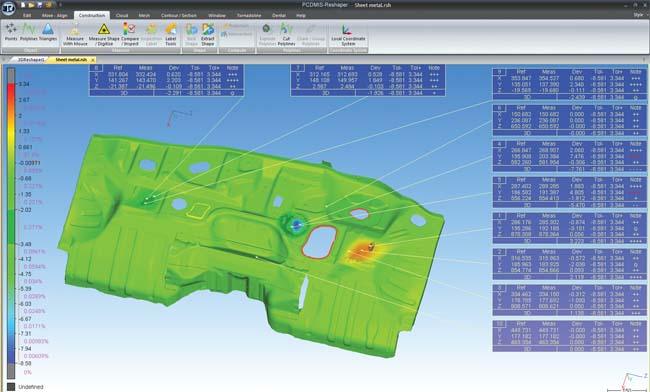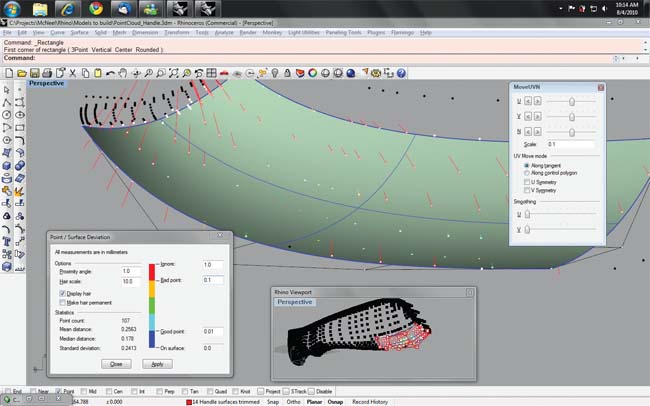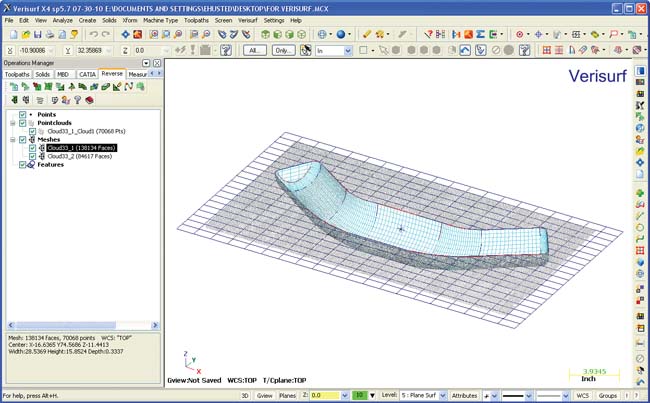How to Choose 3D Point-Cloud Processing Software, Part 2
High-power model creation and handling comes in well-priced packages.
October 1, 2010
By Pamela J. Waterman
Scanning systems based on lasers, structured-light and other non-touch-probe technologies capture millions of data-points referred to as point clouds. Sorting, organizing and combining subsets of these points to represent the true details of physical parts is an intense challenge worth doing and doing well, to save the time of generating CAD files from scratch or to readily compare manufactured parts with their as-intended dimensions.
 Example of sheet-metal part inspection done with Hexagon Metrology’s PC-DMIS Reshaper Inspection3D tool. Image courtesy Hexagon Metrology |
More than a dozen well-respected software packages tackle these jobs in various ways and with different levels of capability. In the September issue of Desktop Engineering, we dug into the nuances of three such packages—Geomagic, PolyWorks and Rapidform—known for their power and the variety of processing options they offer. Now DE turns its attention to an array of task-intensive packages that also offer strong value for the money.
Defining the User and Problem
Are you scanning legacy parts to recreate identical or improved versions? Or instead do you need to make your part fit into someone else’s existing assembly? Lou Gallo, vice president of Digital Dimensions, a design and consulting company that resells SolidWorks products, sees these two questions as the first steps toward choosing point-processing software for reverse engineering.
“Does it matter if it’s parametric or that you can edit it?” asks Gallo. “If the goal is to truly do reverse engineering so you can modify the design and release a different product, then parametric recognition makes it a lot easier to manipulate down the road. If the goal is to try and make a product that’s going to interface to (the scanned piece), then it becomes less important that it’s parametric and more important that it’s accurate.” Reverse engineering software does the former to different degrees, while inspection-oriented software addresses the latter. And if you just want to go directly to additive manufacturing, there are targeted tools for that job, too.
 A point cloud of a 3D part and a surface being fitted to it using the Rhino-3D PointSetDeviation tool. This tool keeps track of the distance of the points to the NURBS surface as the surface is edited. The MoveUVN dialog box is also open; this tool lets users nudge the surface closer to the points. Image courtesy McNeel Software |
Some people also use the term “high end” as a way to distinguish certain point-processing software. However, although the opposite phrase then comes to mind for everything else—“low end”—think instead of these other packages as having tremendous capabilities, too, just in different combinations for a different price point. Large corporations tend to use the high-end packages, while small to medium businesses find the cost-savings of more streamlined packages best suit their needs. (See “Pricing for 3D Point-Cloud Processing Software” sidebar.)
Value-Loaded Point-Cloud Packages
As the classic TV advertisements say, “But wait, there’s more!” For many users in both the reverse engineering and inspection worlds (in fact, about half the market), their tasks can be well served with point-cloud processing software from Verisurf Software, Virtual Grid, McNeel Software, 3D3 Solutions, Materialise and Hexagon Metrology. DE asked each company to point out several features that set its product line apart.
VirtualGrid markets affordable packages targeted to four different end users. VRMesh Reverse includes automatic meshing for reverse engineering; VRMesh Forward offers wire-frame curve detection for creating NURBS surfaces; VRMesh Design offers mesh repair and editing techniques for STL file creation and conceptual design; and VRMesh Studio includes all three versions. The software generates Class A meshed surfaces and Class B NURBS surfaces, with special attention to high-accuracy noise reduction, intelligent point-cloud decimation and remesh smoothing. The company recently released Cloud Decimator for AutoCAD 2011.
Packing extreme power for a great price is Rhino-3D from McNeel Software. Known for its rendering capabilities, Rhino-3D can also import point-cloud data and create, edit and repair meshes from NURBS surfaces. Its approach to free-form NURBS modeling makes it extremely robust, in fact. For example, the company says its ability to match curvature changes across a seam rivals that found in such high-end surface-modeling packages as CATIA and Alias.
 A point cloud of a 3D part and a surface being fitted to it using the Rhino-3D PointSetDeviation tool. This tool keeps track of the distance of the points to the NURBS surface as the surface is edited. The MoveUVN dialog box is also open; this tool lets users nudge the surface closer to the points. Image courtesy McNeel Software |
3D3 Solutions markets Leios 2010 from EGSolutions. The software is used mostly for scan data alignment and data merging, though Thomas Tong, 3D3 Solutions president, adds that about 25% of their customers also use it for deviation analysis and surfacing. “Through extensive testing, we’ve found Leios is one of the most powerful and easy to use stand-alone packages for scan-data cleanup in its price range,” he says. “It has strong automatic (Class B) surfacing features, and most of the surfacing is exported to CAD/CAM packages for refinement.”
At Verisurf Software, director of sales and marketing David Olson explains that his company’s standard solution offers multiple functions. It includes the Verisurf BASIC Class A NURBS modeler, Verisurf Device Interface for connecting to all 3D scanners and Verisurf REVERSE for point-cloud editing. Based on the Parasolid kernel, it creates editable solid models within Verisurf itself, generating surfaces, features, meshes and cross-sections. It opens major CAD files and compares and displays deviations between models and manufactured parts in real time.
A new effort under way at Verisurf Software involves working with aerospace companies and metrology hardware partners to address Outer Mold Line Control technology. The goal is to speed up assembly of fixed composite skins, access panels and hinged hatches while minimizing edge-to-edge steps and gaps.
You may not be familiar with PC-DMIS Reshaper from Hexagon Metrology, but the company’s version 6.0 aims to offer an attractive price point for a product that serves needs in both reverse engineering and inspection. Users cover the gamut of medical/dental fields, architecture/civil engineering/cultural objects, inspection tasks and reverse engineering. Innovative triangulation algorithms provide fast meshing even with noisy data.
Geometry preparation with additive manufacturing in mind is a specialty at Materialise. Among its many products, the company’s family of 3-matic packages (Fixing, CAE and Design) takes scanned data directly to manufacturing using simple to sophisticated approaches. Materialise application engineer Jon Moss says one aspect that sets 3-matic software apart is its ability to manipulate polygonal data using CAD operations. Other features include interfacing directly with many CAE formats, as well as combining data from many different sources into an STL format with options to work on the data with various mathematical controls. Future plans include more macro programming capabilities and possibly brick meshing.
 Scanned part mesh created with Verisurf 3D REVERSE Module. Image courtesy Verisurf |
More for your Money
Looking ahead, the Holy Grail for many users of scanning software is automatic feature extraction. However, this requires knowledge beyond surface shape, including each feature’s design intent and an understanding of the end-use, and may still be five years down the road. In the meantime, engineers are looking for more customizable programming options, better triangle mesh editing, faster task automation and better ease-of-use for occasional users. Given the progress that developers have made in just the past three years, these topics may show up sooner than you think.
| |||||||||||||||||||||||||||||||||
More Info:
3D3 Solutions
Contributing Editor Pamela Waterman, DE’s simulation expert, is an electrical engineer and freelance technical writer based in Arizona. You can send her e-mail to [email protected].
Subscribe to our FREE magazine, FREE email newsletters or both!
About the Author
Pamela Waterman worked as Digital Engineering’s contributing editor for two decades. Contact her via .(JavaScript must be enabled to view this email address).
Follow DE





